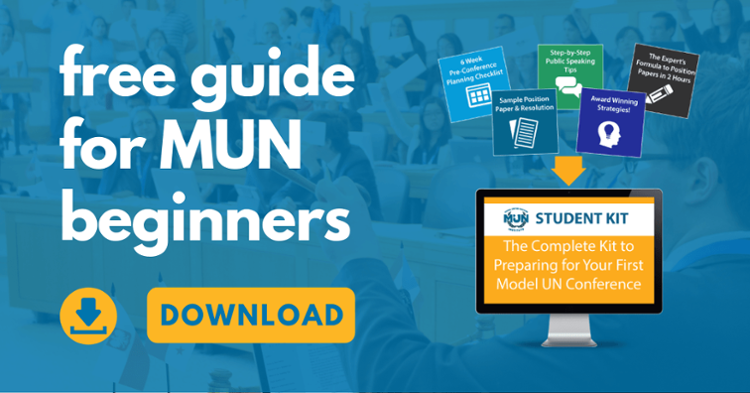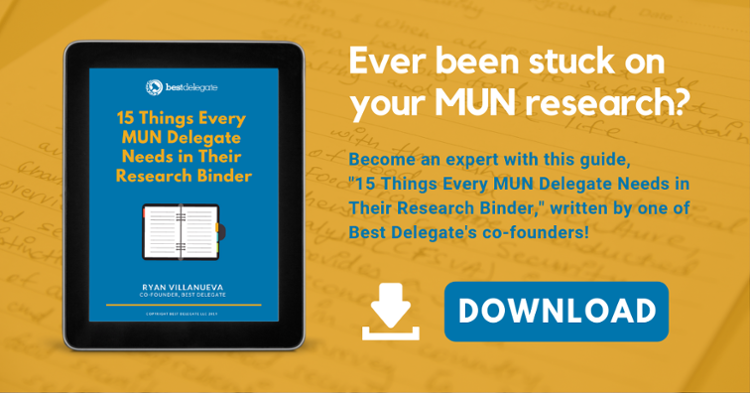Edited by Anish Vedantham, October 2022
Most Model UN conferences require delegates to submit a position paper, an essay covering a country’s perspective on the assigned topics of a conference. Crafting a thorough position paper not only allows you to gain a better understanding of your country and the intricacies of its foreign policy but also to position you to earn awards, be it a best position paper recognition or by supplementing your knowledge to become best delegate. This video showcases the five things you should know about your country when writing a position paper:
An effective position paper can be broken into five simple parts:
1. Heading
The heading is hardly the most important part of a position paper, but it provides the Chair with a snapshot of what your paper will be about. Form should follow function, but it’s much easier for a Chair who’s been reading twenty position papers to judge a book by its cover. By making sure that your heading is clear and organized – and by making sure that you have a header – you’ll help the dais process your paper better and win some brownie points.
While each conference mandates what should be in the heading differently, the general rule is to include your country name, committee, topic, and delegate name. For example, if you were representing South Korea in a DISEC committee on the topic of nuclear disarmament, your heading might look something like this.
Flags and seals are also acceptable, although they should be used sparingly and should be relatively small and not detract from the professionalism of the paper. Furthermore, when dealing with fonts, sticking to a clean, easy to read font like Times New Roman or Arial at a decent size (11 or 12 points) with 1.5 length spacing is the best and easiest for your chairs and for you to find information quickly.
In all, your format is the first impression that you’ll make on the Chair, so it’s best to stand out by not standing out and ensure that your paper looks as normal as possible.

2. Introduction and Topic Background
Like all papers, your position paper needs a good introduction. Chairs will be reading many position papers, so starting off with a good hook will entice them to read further without skimming. Of course, starting off with a quote, a question an “interesting” fact are all very cliché, so the best way to hook your reader is by going into the topic background.
While it may be tempting to rattle off everything you know about the topic: what’s happening, the history of the topic, the technical jargon used while discussing it, the related issues and more, it’s important to remember that Chairs value quality over quantity. To write a good topic background section, you’ll want to provide a little bit of information about the topic and then proceed to analyze it. To do this, you can employ a couple of strategies.
One potential strategy is determining where the issue will go from here by looking at trends and analyzing obstacles to resolving it. This can help show the chair that you are synthesizing with the material and are prepared to handle the topic in committee, where you’re focusing on the present rather than the past. Another way to show that you’ve understood the topic is by breaking the issue down into sub issues. While some background guides may provide sub issues, looking further into the issues and noting the major roadblocks to resolving the issue will show your chair that you’ve understood the issue well.
In a similar vein, make sure to read the background guide well. If your committee is on peacekeeping, you want to ensure that you’ve researched peacekeeping and not peacebuilding.
3. Past Actions by the UN
The past UN actions section of your position paper can either be a great way to stand out and score points with your committee or be relegated to obscurity. Many people tend to list resolutions or treaties that have been undertaken by the United Nations. The delegate may then proceed to explain the resolutions and treaties in depth; however, this only scratches the surface of past UN action.
Your goal in this section is twofold: to look at past solutions – both action plans implemented by the UN and other international organizations and resolutions proposed by the General Assembly and Security Council and analyze those actions and where they went wrong.
By examining specific actions, and looking at their successes and failures, you show the chair that you are engaging with different ideas, and this can help you brainstorm specific actions that you can take. Additionally, by looking at resolutions proposed (whether they passed or failed) you can look at what is currently in effect and what went wrong, and what could have been in effect, who opposed it, and what reasons they had to opposing it. By analyzing the actions, your Chair will have something more interesting to read than a list and explanation of the same treaties and will allow you to brainstorm viable solutions easier.
4. Country Policy
It’s easy to assume country policy by looking at geographic region and your country’s allies or to write off policy altogether since you can’t find anything. But, claiming to be a neutral nation when you have some stake in the matter will case you to lose standing with the dais but also reduce your own enjoyment in the conference.
When researching country policy, you should be looking both at international action (resolutions voted for/against, programs supported/been involved with) and domestic action (legislation and policies within the country). You should also look at trends to see what your country favors/doesn’t favor broadly and understand the general goals of your country – whether those be sovereignty, human rights, or a focus on Islamist principles.
Country policy is the section that truly makes your position paper unique from others, and by taking a clear stance and by understanding your policy in depth, you’re able to form opinions and judgments from the perspective of your country on a whole host of issues whether you researched them in their entirety or not.
5. Proposed Solutions.
Solutions are by far the most crucial step in your position paper and should be the qualitatively densest part. Using the sub issues you addressed in the topic background section, the history of what has and hasn’t worked in the past UN action section, and your general philosophy and specific domestic actions from your country policy, you can begin to build an arsenal of solutions that will withstand scrutiny.
To frame this, start by thinking of any programs that need to be removed or discontinued, as the UN is always looking to save resources. Then, shift your focus to amending current programs, such as changing the scope of a peacekeeping mission, or changing the roles of an existing organization. Finally, drop the bombshell and talk about any proposed new solutions that you might have – especially those that have worked in your country before – and explain how they will work.
Finishing off your solutions paragraph, you should recap in brief the solutions that you’ve proposed and again highlight why they will work to resolve the issue.
A Couple Notes
- Remember: Quality over Quantity. Chairs are reading many position papers so an absurdly long one will make them tune out and lose focus. Be as concise as possible.
- Avoid technical jargon. While a little bit of jargon will make you seem professional and using one or two Latin terms never hurt anyone; aim for comprehension.
- Remember to cite your sources using either in text citations or footnotes.
- Reframe writing a position paper as a step in the research process rather than a chore.
About Crisis
A crisis position paper is in some ways, remarkably different than a GA one. Many of the sections do not apply at all and others are difficult to replicate. It’s helpful to structure your crisis position papers as a letter – using personal pronouns – covering the background of the issue using the tips mentioned above, talking about your personal philosophy (political, economic, social, religious, etc.), and then addressing specific solutions you have with evidence that they will work. Crisis position papers are considerably easier and shorter than GA ones, so feel free to experiment and have fun. Especially with historical crises, take some dramatic liberties and use more poetic language to draw your reader in. Above all, remember that seeing as you’ll be thrown challenge after challenge, so a personal philosophy is much more applicable than a specific set of solutions.
Position papers, despite their bad name, are an extremely useful tool for your Chairs and for you, so make the most out of them.
Tackle your writing in these five sections to create a position paper that packs a punch!


